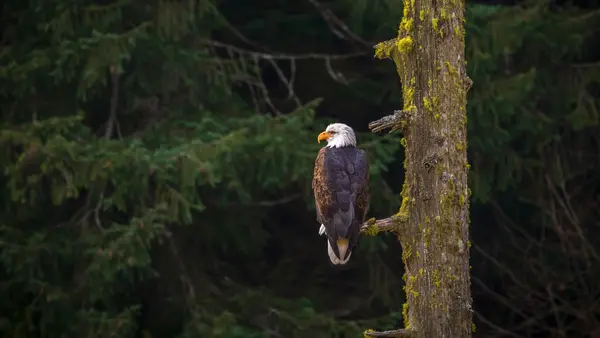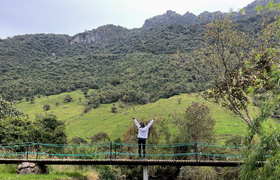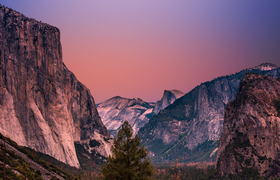
The most paw-some animals of North America
From huge and scary to small and dainty, these iconic species are some of the most unique and well-known creatures in Canada and the United States
With North America’s vastly diverse ecosystems and huge amount of wild land, it’s no surprise that the continent also has some of the coolest animals on the planet. Sure, you won't see wild elephants or cheetahs, but how about grizzly bears, bison, and bobcats? Those North American legends are just a few of the animals you might spot, perhaps while hiking around the United States or Canada. Here are iconic animals in North America that you — and your camera — might catch a glimpse of while adventuring.
Bald eagle
As the national animal of the United States, the bald eagle is about as iconic as they come. Bald eagles can be found all over the continent near coasts, rivers, lakes, and reservoirs where they can catch — or steal — fish. With their white-feathered head and brown body and wings, these elegant birds soar through the air on their own and gather by the hundreds to breed in the winter in Canada and Alaska. A few are known to nest along the Colorado River near Moab, Utah.
Spot them for yourself on: Hiking Utah's Mighty 5
Grizzly bear
Grizzly bears are a subspecies of the brown bear — the main difference is geographic location. The brown bear typically lives in the coastal areas of Alaska, while grizzlies live inland. These huge wild creatures can weigh upward of 315kg (700 lbs) and are definitely not an animal to mess with! While the species used to range all over the western part of North America from Alaska down to Mexico, they are now only found as far south as Yellowstone and the Grand Tetons. The grizzly is California’s state animal and appears on the state flag; however, no grizzlies have lived in California since 1924 (though there is a recent possibility that they could be reintroduced).

Spot them for yourself on: Journeys: Iconic Wildlife of Yellowstone and Grand Teton
Black bear
While sometimes confused with the brown bear, black bears are smaller and far more widely distributed across North America. Despite their misleading name, black bears can actually be a wide range of colours, from black to gray to cinnamon to white, so don’t rely on coloration to identify them. Black bears are typically not aggressive and are cool to see in nature, but they are still wild, powerful animals known to go after human food. If you’re in an area with black bears, be sure you’re storing food appropriately.
Spot them for yourself on: Yellowstone Camping Explorer
Bison
In 2016, the bison became the national mammal of the United States in part as a nod to the species’ conservation success story. These massive creatures used to roam all around North America, but in the 1800s, European settlers hunted them almost to extinction. Now, the population has grown to a point where the species is no longer threatened. One of the most common places to see bison is around Yellowstone National Park, which has an estimated 4,900 of them. Bison might look fluffy and friend-shaped, but do not approach them. They’re much better as long-distance friends.

Spot them for yourself on: Journeys: Iconic Wildlife of Yellowstone and Grand Teton
American alligator
The scaly, dinosaur-like alligator can be up to 3.6m (12 ft) long and weigh up to 450 kg (1,000 lbs). While cool to see from a distance, these dangerous carnivores aren’t an animal you want to get in a fight with! The good news is, they’re mostly not trying to get in a fight with you and typically mind their own business. Alligators live in the southern United States from North Carolina to Florida and as far west as Texas.
Elk
The second-largest species in the deer family, elk can weigh up to 408kg (900 lbs). Elk are most commonly known for their impressive antlers, which can weigh up to 18kg (40 lbs), though only the males have antlers. Four types of elk live in North America, including the Roosevelt (coastal Pacific Northwest), Tule (Central California), Manitoban (northern Great Plains), and Rocky Mountain (Rocky Mountain West) elk.

Moose
We talked about the second-largest species in the deer family, so we should probably mention the largest, too: the moose. It’s also the tallest and second-largest land animal in North America; only the bison is bigger. These enormous creatures can be up to 2m (7 ft) tall at the shoulder, and a mature male can weigh up to 700kg (1,550 lbs). If you’re hoping to spot moose, most of the population ranges in the northern part of the continent in Canada and Alaska, though you can also see them in many of the northern states of the Lower 48 and, in isolated areas, as far south as Utah and Colorado.
Spot them for yourself on: Journeys: Discover the Canadian Rockies - Westbound
Pronghorn antelope
The pronghorn antelope is made for speed. These goat-sized hoofed animals are the fastest land animals in North America, reaching speeds of up to 96km/h (60 mph). But they aren’t just good sprinters — they also travel long distances. Pronghorns have the longest land migrations in the continental United States, travelling 240km (150 mi) each way between Wyoming’s Upper Green River Basin and Grand Teton National Park.

Spot them for yourself on: Yellowstone Camping Explorer
Cougar
Many people think cougars and mountain lions are two different animals, but they’re actually just two common names for the same species. In fact, puma is also a common name for the same species. Cougars have so many names, mostly because it has such a wide range. They live all over the Americas, from the Canadian Yukon to the southern part of Chile.
Beaver
The North American beaver might be one of the most celebrated rodents out there. These creatures are a national symbol of Canada and the official state mammal of Oregon and New York. Beavers are most well known for their dam-making capabilities, dramatically impacting their surrounding environment by creating ponds and disrupting the water system. This skill makes them an essential part of ecosystems that have adapted to their dams, but also makes them an enormous pest in areas that aren’t used to the impact.

Spot them for yourself on: Active Canadian Rockies Adventure
Gray wolf
Another favourite animal to see in Yellowstone National Park, the gray wolf is about as iconic as they come. They’re the distant relatives of our favourite canine friends, after all! While the gray wolf population used to be widespread across the majority of North America, the species lost most of its range because of hunting and habitat loss and is now endangered. However, the good news is that thanks to conservation efforts, these powerful creatures are making a comeback.
Spot them for yourself on: Journeys: Iconic Wildlife of Yellowstone and Grand Teton
Gray whale
These endangered behemoths of the sea may not be as big as the blue whale, but they’re still pretty darn huge, weighing about 40,800kg (90,000 lbs). These impressive marine mammals are best known for their long annual migration, travelling 16,100km to 22,500km (10,000 mi to 14,000 mi) annually round trip. If you want to catch a glimpse of a gray whale on the move, your best bet is taking a whale-watching tour in the summer in Washington, Canada, or Alaska. However, the whales travel just about the full length of the west coast of North America, spending the summers up north from Alaska to California and the winters breeding in Baja California, Mexico.

Spot them for yourself on: Canadian Rockies: National Parks Westbound
Bobcat
At first glance and from a distance, you might confuse the bobcat with an extra-large house cat, but with a closer look, you’ll realize these elegant felines are significantly bigger and have a shorter tail and pointier ears. Bobcats range throughout North America from Mexico to northern Canada, but they’re most common in the United States. These creatures are often pretty sneaky, so if you happen to see one, count yourself lucky.
Monarch butterfly
The smallest creature on this list, the monarch butterfly has one of the mightiest migrations of all time. As a species, the group travels upwards of 4,800km (3,000 mi) each way. These eye-catching orange and black butterflies are one of the few insect species that take on a migration, and they manage it each year on their own, having never done the trip before, thanks to an internal compass of sorts. During overwintering, the butterflies go to specific groves each year, where, if you look closely, you can sometimes see clusters of thousands of the little insects hanging off trees. The clusters often look like leaves or moss hanging from the trees, but if you use binoculars or a zoom lens, you can see the hundreds of closed wings huddled on the branches.

Caribou
Caribou, also known as reindeer, have the longest land migration on the planet, sometimes travelling 3,200km (2,000 mi) each year throughout Canada and Alaska. Yes, they do look like the animals that might fly through the sky pulling Santa’s sled, and yes, these animals are known to pull sleds from time to time. But no, they do not have red noses. Head to Denali National Park if you want to see massive herds of these wild animals.
Spot them for yourself on: Hike Alaska: Glaciers and Denali




